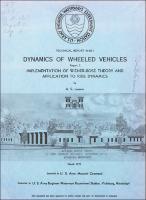Please use this identifier to cite or link to this item:
https://hdl.handle.net/11681/29259| Title: | Dynamics of Wheeled Vehicles. Report 2, Implementation of Wiener-Bose Theory and Application to Ride Dynamics |
| Authors: | Lessem, Allan S. Mobility and Environmental Systems Laboratory (U.S.) |
| Keywords: | Mississippi State University--Dissertations Motor vehicles--Dynamics Mathematical models System analysis Dissertations, Academic--U.S. Army Engineer Waterways Experiment Station |
| Publisher: | U.S. Army Engineer Waterways Experiment Station |
| Series/Report no.: | Technical Report (U.S. Army Engineer Waterways Experiment Station);no. M-68-1 Rept.2 |
| Abstract: | Wiener-Bose Theory is a strategy for identifying nonlinear systems in terms of a set of "characterizing coefficients." These are obtained through the agency of a certain probing process carried out on each system. Once the coefficients have been determined they must be used in a rational synthesis procedure to predict responses to inputs of interest. The principal appeal of Wiener-Bose Theory is that it requires very little knowledge of the physics of the system. No dynamical equations need be written. In essence the physics of the system is incorporated into the characterizing coefficients. It is this property of Wiener-Bose Theory that makes its application to vehicle ride dynamics studies attractive. The present strategy for ride dynamics studies invokes the use of structure-oriented mass-spring dashpot models based on rigid body mechanics. These models are characterized by the need for repeated "tuning" in which model parameters are altered in a basically irrational way when comparisons are made to different sets of responses of actual vehicles. A computer study was conducted to discern problems of implementation of the theory. Several systems of increasing complexity were studied and a practical form of Wiener-Bose Theory evolved. The systems studied were as follows: (a) a zero-memory system, (b) rate-independent hysteresis, (c) a second-order system with saturation, and (d) a fourth-order mechanical system with nonlinear compliances. The experience gained during this study was summarized in a set of guidelines for the construction of Wiener-Bose models. A program of testing was carried out to ascertain the practicality and utility of Wiener-Bose Theory for ride dynamics studies. A military M37, 3/4-ton truck was selected for characterization using a Wiener-Bose model having 1024 coefficients. The characterizing coefficients were obtained by utilizing the responses of the vehicle recorded during traversal of a specially configured obstacle course whose total length was 2.5 miles. Once the coefficients were obtained, they were used to synthesize responses to specific terrain profiles. These predicted responses compared favorably with counterpart responses of the vehicle traversing the same profiles. It was concluded that Wiener-Bose Theory is capable of satisfactory performance in the analysis of many nonlinear systems. The principal difficulty in its practical application is the extensive probing effort required for characterizing the system. |
| Description: | Technical Report |
| Gov't Doc #: | Technical Report M-68-1 Report 2 |
| Rights: | Approved for public release; distribution is unlimited |
| URI: | http://hdl.handle.net/11681/29259 |
| Appears in Collections: | Technical Report |
Files in This Item:
| File | Description | Size | Format | |
|---|---|---|---|---|
| Technical Report M-68 Rept.2.pdf | 9.25 MB | Adobe PDF |  View/Open |